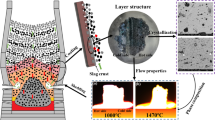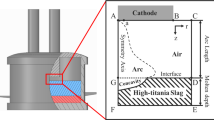Abstract
The core of the long-life copper stave was to ensure the stability of the slag layer, and the uniform distribution of the slag layer was beneficial to restrict the generation of the overthick slag layer. A novel model for calculating the thickness and distribution of the slag layer in the part of copper stave was established based on the finite element theory through the ANSYS birth-death element technology. The distribution and thickness of the slag layer on the hot surface of copper stave were calculated and analyzed when the gas temperature and slag properties tended to be changed, which was applied to characterize the slag-hanging capability of copper stave with the changes of furnace conditions. It was shown that the thickness of hot surface slag layer in the part of copper stave decreased obviously while the temperature of stave body raised rapidly with increasing gas temperature. When the gas temperature was 1400 °C, the inlaid slag layer was gradually melted, and the maximum temperature of the stave body was closed to 120 °C. The change of gas temperature was very sensitive to the adherent dross capability of copper stave which would be enhanced by the promotion of slag-hanging temperature. However, when the slag-hanging temperature was 1150 °C and the gas temperature was lower than 1250 °C, the overthick slag layer was easily formed on the hot surface of the copper stave, and its stability was poor. The improvement in the thermal conductivity of slag could be conducive to the formation of the uniform and stable slag layer on the hot surface of copper stave, especially in the dovetail groove. When the thermal conductivity of the slag was greater than 1.8 W m−2 °C−1, the inlaid slag layer in the dovetail groove was not melted, although the gas temperature reached 1500 °C.










Similar content being viewed by others
References
S. Manmohan, V. Sankalp, Int. J. Inventive Eng. Sci. 2 (2014) 10–16.
I.F. Kurunov, V.N. Loginov, D.N. Tikhonov, Metallurgist 50 (2006) 605–613.
S.R. Zhang, J. Iron Steel Res. Int. 13 (2006) No. 6, 1–7.
Y.L. Li, S.S. Cheng, C. Chen, J. Iron Steel Res. Int. 22 (2015) 382–390.
L.J. Wu, X. Xu, W.G. Zhou, Y.L. Su, X.J. Li, Int. J. Heat Mass Transfer 51 (2008) 2824–2833.
A. Kumar, S.N. Bansal, R. Chandraker, Mater. Phys. Mech. 15 (2012) 46–65.
R. Hathaway, K.S. Nanavati, D.H. Wakelin, Ironmaking Conf. Proc. 58 (1999) 35–46.
K.X. Jiao, J.L. Zhang, Z.J. Liu, Y. Deng, C.L. Chen, J. Iron Steel Res. Int. 25 (2018) 1010–1016.
F.M Zhang, J. Iron Steel Res. Int. 20 (2013) No. 9, 53–60.
P. Heinrich, J. Buchwalder, in: ISSTech 2003 Conference Proceedings, ISS, Warrendale, PA, USA, 2003, pp. 1091–1102.
F.G. Li, J.L. Zhang, L. Wei, H.B. Zuo, Y.J. Duan, J.L. Jia, in: National Technical Seminar on Blast Furnace Longevity and High Wind Temperature, The Chinese Society for Metals, Beijing, China, 2012, pp. 46–54.
Y.W. Huan, L.P. Lei, G. Fang, P. Zeng, J. Xu, Z.P. Zou, Metall. Equip. (2009) No. 3, 45–49.
G. Cegna, O. Lingiardi, R. Musante, in: AISTech-Iron and Steel Technology Conf. Proc., Association for Iron and Steel Technology, Indiana, USA, 2014, pp. 683–694.
N.Q. Xie, S.S. Cheng, J. Iron Steel Res. Int. 17 (2010) No. 1, 1–6.
Q. Liu, S.S. Cheng, Int. J. Therm. Sci. 100 (2016) 202–212.
Q. Liu, P. Zhang, S.S. Cheng, P.J. Niu, D.D. Liu, Int. J. Heat Mass Transfer 103 (2016) 341–348.
L. Qian, S.S. Cheng, J. Univ. Sci. Technol. Beijing 28 (2006) 1052–1057.
S.S. Cheng, L. Qian, H.B. Zhao, J. Iron Steel Res. Int. 14 (2007) No. 4, 1–5.
T. Wu, S.S. Cheng, Iron and Steel 46 (2011) No. 10, 11–15.
T. Wu, S.S. Cheng, Ironmaking 30 (2011) No. 5, 26–30.
T. Wu, S.S. Cheng, J. Iron Steel Res. Int. 19 (2012) No. 7, 1–5.
S.W. Choi, D. Kim, Rev. Prog. Quart. Noudestr. 1430 (2012) 1715–1721.
A. Ganguly, A.S. Reddy, A. Kumar, ISIJ Int. 50 (2010) 1010–1015.
C.P. Yeh, C.K. Ho, R.J. Yang, Int. Commun. Heat Mass Transfer 39 (2012) 58–65.
F.G. Li, J.L. Zhang, Chin. J. Eng. 38 (2016) 546–554.
S.S. Cheng, T.J. Yang, W.G. Yang, Q. Quan, Q.C. Wu, Iron and Steel 36 (2001) No. 2, 8–11.
J.H. Cui, Y.F. Sun, R.B. Yu, Y.M. Gao, Y. Zhang, R. Liu, C.B. Sha, Foundry Technology 27 (2006) 851–854.
X.L. Wang, Questions and answers on blast furnace production knowledge, 3rd ed., Metallurgical Industry Press, Beijing, China, 2013.
Acknowledgements
The authors were especially grateful to the National Natural Science Foundation of China (No. 51904063), Fundamental Research Funds for the Central Universities (Nos. N172503016, N172502005, and N172506011) and China Postdoctoral Science Foundation (No. 2018M640259).
Author information
Authors and Affiliations
Corresponding author
Rights and permissions
About this article
Cite this article
Shi, Q., Tang, J. & Chu, Ms. Numerical simulation of slag layer and its distribution on hot surface of copper stave based on ANSYS birth-death element technology. J. Iron Steel Res. Int. 28, 507–519 (2021). https://doi.org/10.1007/s42243-021-00559-5
Received:
Revised:
Accepted:
Published:
Issue Date:
DOI: https://doi.org/10.1007/s42243-021-00559-5




